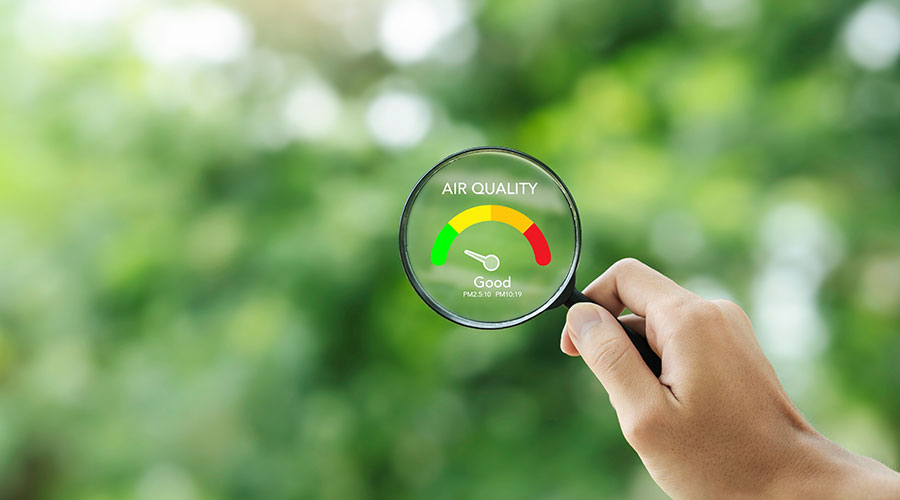3 Cost-Effective Ways to Improve School Indoor Air Quality This Winter
The Healthy Green Schools & Colleges standard provides a framework facility managers can take to improve the sustainability and IAQ on their campuses.
By Sara Porter, Contributing Writer
As winter temperatures bring higher rates of viruses, including influenza and COVID-19, maintaining good indoor air quality is more important than ever.
The pandemic highlighted the dramatic under-investment in school facilities nationwide and the very real impacts on students. Even before the pandemic, nearly half of U.S. schools reported indoor air quality problems that put the health of students and staff at risk. On top of contributing to health concerns, issues such as failing HVAC systems, poor ventilation, and chemical exposure are linked to poor concentration and test performance in students, adding preventable barriers to achievement.
These challenges also affect the broader school community, including educators and staff members. In fact, nearly 80 percent of teachers responding to a survey in Chicago and the District of Columbia reported that school facility conditions were a key factor in teaching quality. Approximately half of those who graded their facilities “C” or below would consider leaving — and the most frequently cited problem was bad indoor air quality.
Indoor air quality is complex and affected by many factors, but there are some cost-effective ways to foster healthy indoor environments for students and staff during the colder winter months.
Improving IAQ
While the challenge is formidable, progress is attainable, even with a limited budget. Improving indoor air quality in schools is not an all-or-nothing proposition; there are measures that can make a dramatic difference without requiring a full infrastructure overhaul.
The Healthy Green Schools & Colleges standard, created in partnership with Green Seal and Healthy Schools Campaign, is a free and publicly available resource that highlights dozens of accessible steps school facility leaders can take to improve the sustainability and indoor air quality on their campuses.
Here are a few of the most impactful changes facility management professionals can make to improve the health and safety of their school’s indoor environments this season:
1.) Establish an HVAC Maintenance Plan
HVAC systems control the air exchange in the room and clean the air, making them a critical part of maintaining healthy indoor air quality. Even with older systems, proper maintenance is essential to ensure the components are working as effectively and efficiently as possible.
A maintenance plan formalizes standard operation procedures and should include regular or quarterly HVAC system inspections using the U.S. Environmental Protection Agency (EPA) ventilation checklist from Tools for Schools. This means quarterly cleaning of clean air supply diffusers, grilles, return registers, and outside air intakes to prevent contaminants from entering the system and spreading around the room. It should also include quarterly inspections of outside air intakes to ensure they work properly and that no standing water is in their vicinity, and of the building automation system, dampers, actuators, and physical system components.
2.) Assess Ventilation
Ventilation is critical to building occupant health and performance. In fact, a study by Lawrence Berkeley National Laboratory found that students in classrooms with higher outdoor air ventilation rates score up to 15 percent higher on standardized tests.
Every school’s HVAC system should meet the minimum requirements of the ANSI/ASHRAE ventilation standard for acceptable indoor air quality. Documenting an HVAC system’s outdoor air intake flow rates is the first step toward improving ventilation if it is not up to par. One way to do this is to follow the ventilation guidelines in the WELL Health and Safety rating, including having a qualified engineer provide the school with an assessment of the extent to which the current mechanical system in each building can operate without recirculating air; the highest supply rate of outdoor air the current mechanical system can provide; and whether modifications to system controls could increase the supply of outdoor air (for example, ventilating for longer hours).
Then, make sure the report includes information on how any potential HVAC system modifications would affect the energy consumption, thermal comfort conditions, and maintenance processes.
If the HVAC system cannot achieve adequate ventilation and air exchange for the occupancy level, providing supplemental air-cleaning systems (such as standalone HEPA filtration units) in classrooms and other assembly areas can get air quality to where it needs to be.
3.) Interview Building Occupants
Students, teachers, and staff are experts on which areas of school buildings are uncomfortable or problematic for them. Leverage their insights this winter by interviewing building occupants in schools that experience frequent indoor air quality issues to help identify problem areas. Include the school nurse and other staff members who regularly engage with students and staff to identify any trends in health complaints.
Alternatively, set up an ongoing communications channel for all building occupants across the institution to identify indoor air quality issues, problem areas, and health complaints that may be related to indoor air quality.
Self-assessment for schools
School facility professionals are constantly doing a lot with a little. Budget realities often mean a lack proper funding and resources for the essential work of creating a healthy environment for students and staff.
The Healthy Green Schools & Colleges program offers a free self-assessment tool for school facility leaders to objectively measure building performance and identify opportunities for improvement. Developed with input from facility executives from award-winning schools and universities, the recommendations focus on practical measures that can be implemented without major capital investments.
The way that schools manage their facilities speaks to how they value their students, staff, and surrounding communities. The Healthy Green Schools & Colleges standard can help facility professionals identify an actionable path to providing the best indoor air quality possible in a resource-constrained environment.
Sara Porter serves a dual role as both the vice president of external affairs at Healthy Schools Campaign (HSC) and the director of Healthy Green Schools & Colleges, a partnership between HSC and Green Seal.
Related Topics:












